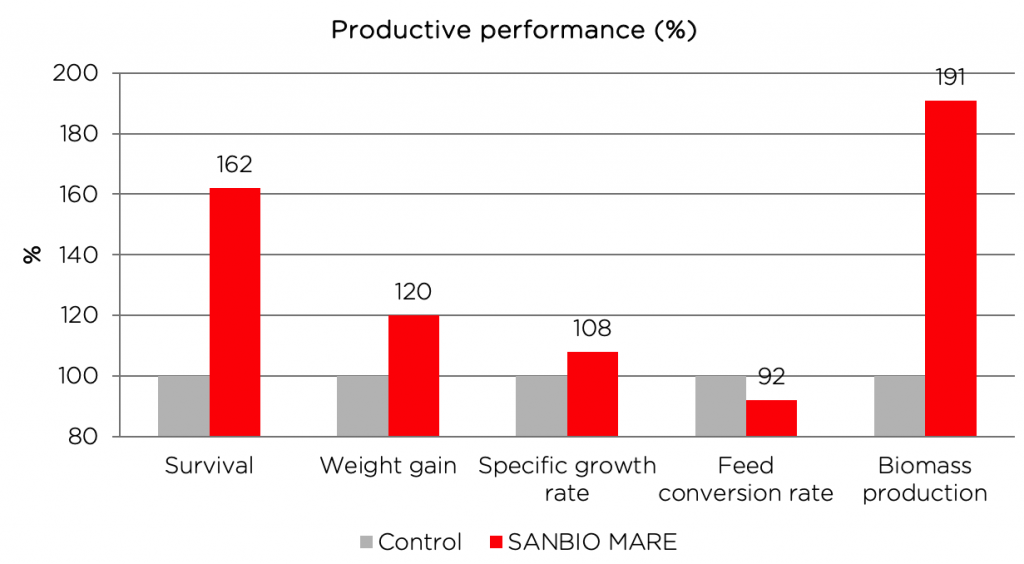Gutenborn, Germany (August 05, 2015) – Tilapia is recently recognized as global fish and described as the important aquaculture species of the 21st century. Farming practices of the fish from extensive to super-intensive both for fresh and brackish waters are being expanding day by day in many countries of the world.
The objective of the trial what to evaluate the efficiency of functional feed Sanbio MARE added to normal diets for Red Tilapia fed compared to similar diets but without addition of Sanbio MARE. The trial was performed according to the Best Practice Guideline by targeting the sensitive parameter (mortality, weight gain, feed intake, feed conversion rate). The SANBOS GmbH, in cooperation with local partners, conducted a tank feeding trial with Red Tilapia (Oreochromis sp. ‘Red Tilapia’). The objective of the trial was to demonstrate Red Tilapia growth and performance in fresh-water tanks with a partial replacement of fish feed by the functional feed Sanbio MARE.
1. Materials and methods
Four cages of average size 2 m3 (underwater volume). Tanks were constructed of glass fiber reinforced plastic.
Fish were 230 g Red Tilapia produced locally. Red Tilapia were stocked in the four trial tanks on 10 June at a density of 800 fish per tank. Fish in all four trial tanks were of uniform size, age and health status at stocking.
Red Tilapia in the control tank were fed with 100% of standard growout feed in extruded, floating pellet form as per Table 1.
Red Tilapia in treated trial tanks were fed with 80% of standard growout feed in extruded, floating pellet form as per Table 1 and 20% of Sanbio MARE as per Table 2.
Fish were fed to satiation twice daily, with fish in all four tanks fed identically at every feeding. Feed pellet size was increased as the fish grew so that the maximum size pellet that all fish could consume was being fed.
Trial management was based on the best practice standards.
Fish in all tanks were sampled once per month on approximately the same date each month.
At the conclusion of the trial, all tanks were emptied and the fish in each tank counted and weighed to determine average fish weight, gross and net production, feed conversion ratio (FCR) and survival. Production input costs were recorded throughout the trial and net income and return on investment (ROI) were calculated at the end of the trial.
Table 1. Formula for the standard fish feed used in the trial
| Pellet size (mm) | 3 / 4.5 |
| Crude protein (%) | 42 |
| Crude fat (%) | 12 |
| NFE (%) | 28 |
| Ash (%) | 6 |
| Fibre (%) | 3 |
| P (%) | 0.9 |
| Gross energy (MJ) | 20 |
| Digestible energy (MJ) | 16 |
Table 2. Formula for the “Sanbio SANA” fish feed supplement used in the trial
| Pellet size (mm) | 3 |
| Crude protein (%) | 40 |
| Crude fat (%) | 10 |
| Ash (%) | 8 |
| Fibre (%) | 4.7 |
| P (%) | 1.5 |
| Amino acids | 5 |
| Vitamins | 1 |
| Carbohydrates | 5 |
| Minerals | 5 |
| Formate | 2.5 |
| Gross energy (MJ) | 22 |
| Digestible energy (MJ) | 18 |
2. Results
Red Tilapia were fed a total of 100 days between 14 June and 23 September 2010. Red Tilapia grew from 80 g to an average weight of 786 g (+18% compared to control) during this feeding period.
Gross production averaged 596.83 kg per cage (+38% compared to control). Average Red Tilapia survival rate was 97.33% (+62% compared to control). Average FCR for Red Tilapia was 1.29 (-8% compared to control).
Table 3. Productive performance
| Cage no. | Unit | 1 | 2 | 3 | 4 | Average 2/3/4 |
| Cage | Control | Trial 1 | Trial 2 | Trial 3 | ||
| No day fed | D | 100 | 100 | 100 | 100 | |
| Stocking rate | Fish/tank | 800 | 800 | 800 | 800 | 800.00 |
| Harvest rate | Fish/tank | 480 | 784 | 776 | 776 | 778.67 |
| Mortality | % | 40 | 2 | 3 | 3 | 2.67 |
| Survival | % | 60 | 98 | 97 | 97 | 97.33 |
| Fish stocking weight | g | 80 | 79 | 81 | 80 | 80 |
| Fish harvest weight | g | 668 | 787 | 785 | 786 | 786 |
| Weight gain | g | 588 | 708 | 704 | 706 | 706.0 |
| Specific growth rate | SGR | 2.12 | 2.30 | 2.27 | 2.28 | 2.28 |
| Production | kg/tank | 320.6 | 617 | 609.2 | 609.9 | 612.03 |
| kg/m3 | 160.3 | 308.5 | 304.6 | 305.0 | 306.02 | |
| Feed intake | kg/tank | 449 | 808 | 761 | 793 | 787.5 |
| FCR | 1.4 | 1.31 | 1.25 | 1.3 | 1.29 |

Figure 1. Productive performance (%)
3. Conclusion
To summarize, the present study shows significantly positive effects of SANBIO MARE at the dosage of 20% of diet on productivity.
The positive effects at a glance:
- Reduction of mortality
- Increase of weight gain
- Improvement of FCR
- Positive effects on health status
- Safety and tolerance when used dietary additions.